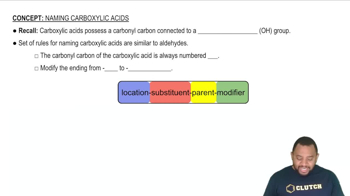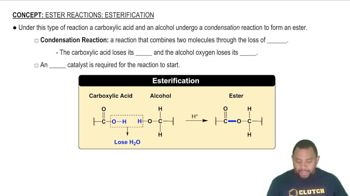Here are the essential concepts you must grasp in order to answer the question correctly.
Carboxylic Acids
Carboxylic acids are organic compounds characterized by the presence of a carboxyl group (-COOH). This functional group consists of a carbon atom double-bonded to an oxygen atom and single-bonded to a hydroxyl group (-OH). Carboxylic acids are known for their acidic properties and are commonly found in various biological and industrial processes.
Recommended video:
Rules for Naming Carboxylic Acids
Esterification
Esterification is a chemical reaction that forms esters from carboxylic acids and alcohols. During this process, the hydroxyl group of the carboxylic acid reacts with the hydrogen of the alcohol's hydroxyl group, resulting in the release of water and the formation of an ester bond (-COO-). Esters are often characterized by their pleasant fragrances and are widely used in flavorings and fragrances.
Recommended video:
Ester Reactions: Esterification
Structural Representation
Structural representation in chemistry involves depicting the arrangement of atoms within a molecule. For carboxylic acids and esters, this includes showing the functional groups and the carbon chain. Understanding how to draw these structures is essential for visualizing molecular interactions and predicting chemical behavior, particularly in organic chemistry.
Recommended video:

 Verified step by step guidance
Verified step by step guidance


